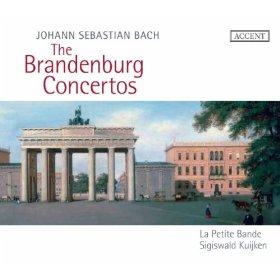
J.S. Bach: The Brandenburg Concertos
Sigiswald Kuijken and La Petite Bande
Jean-François Madeuf, trumpet and horn; Pierre-Yves Madeuf, horn
A=415Hz, recorded October 2009
Accent Records, ACC 24224
With so many high-quality historically-informed recordings, one might think that there is little reason to re-record Bach’s Brandenburg Concertos. While that might be true for some, staunch brass purists know that there has never been a recording of the Second Brandenburg using a natural trumpet without any modernization to assist with tuning. No recording, that is, until the present 2009 recording by La Petite Bande with Sigiswald Kuijken conducting (Jean-François Madeuf on trumpet). Kuijken’s recording of the set wears its agenda plainly on its sleeve (pardon the pun): to be the first “no compromises” historical recording of the six works and to do so with artistic and listenable results.
The ramifications of a true no-compromise approach to these works are manifold, and some of them have nothing to do with the trumpet. Kuijken and his players hold themselves to this standard with commendable zeal. First, he feels compelled to play Concertos Nos. 1 and 2 with only one player per part (including the accompanimental/orchestral parts). Noting that conductors have long accepted that Concertos Nos. 3-6 have been performed in this way, he states that he can see no reason for approaching the first two works of the set any differently. The debate over the forces at Bach’s disposal has raged for decades (especially regarding multiple singers in Bach’s choral music) and will doubtless never be resolved to everyone’s complete satisfaction. The present reviewer is of the opinion that the few surviving sources do not require Kuijken’s hard-line stance for these works, but neither do they refute the possibility that Bach used one player per part. Second, Kuijken feels the need to use the violoncello da spalla (a “shoulder cello” upon which he has elsewhere recorded Bach’s cello suites) as his cello of choice, citing recent research that this instrument, rather than the “normal” cello, was what Bach normally indicated with his generic term “violoncello.” I am not in an informed enough position to evaluate the merits of this approach, but concede Kuijken’s point that the result is a continuo section that is “very transparent and yet solid support” for the ensemble. Admittedly, I probably would not have noticed any difference had he omitted the reference in his liner notes.
The most daunting impediment to a true no-compromise recording of the Brandenburg Concertos is, of course, the remarkable solo trumpet part in Concerto No. 2, BWV 1047. The increasing number of “historically-informed” performances of this work have one commonality: the use of vents (extra holes) to tune the natural trumpet’s 11th and 13th partials. Many also make a variety of hidden compromises in lead-pipes, mouthpieces, and bell shapes. Jean-François Madeuf, the HBS’s 2009 Christopher Monk Awardee, meets this challenge head-on. Playing a faithfully reproduced unvented early eighteenth-century J.W. Haas trumpet and an unnamed “conscientious copy of the period mouthpieces,” Madeuf performs commendably and virtuosically. I doubt that any 1720s trumpeter could have played the piece any better than Madeuf does on this recording, and few modern-day trumpeters could equal Madeuf’s feat given the same equipment restrictions. The recording includes the quirks typical of any unvented natural trumpet recording, most audibly the occasionally out-of-tune 11th and 13th partials. Madeuf’s ability to bend these pitches into tune has minimized the tuning problem to a remarkable extent. Another noticeable result is the trumpet’s somewhat foggy sound in its highest register (above the 14th partial). This too is part of the instrument’s sound when playing without the clarity provided by nodal holes. In Madeuf’s case, the fogginess is unduly accentuated by the crisp playing produced by Kuijken’s one performer to a part policy. In spite of this mountain of technical difficulties, Madeuf’s playing is superb.
As might be expected given the laws of physics, these same problems appear on the recording of Concerto No. 1, BWV 1046, where Madeuf’s horn playing, and that of his brother Pierre-Yves Madeuf, is quite good nevertheless. Here the brothers have opted not to use hand-stopping whatsoever. This makes for a more raucous, rustic sound on the whole, but also highlights the difficulties of tuning unvented horns. Perhaps they would have been better served to stop some of the sections when necessary (surely this would not have violated their strict approach?), particularly towards the end of the first movement (~3:00) where both horns play out-of-tune partials simultaneously. Of course, if Bach’s horns did not hand-stop either, then the results would have been the same as on this recording, but it seems highly unlikely that 1720s horn players did not use the technique as needed.
While technical accomplishment is nice, the goal any recording must be something that is artistic and enjoyable to hear. Having played an unvented natural trumpet for many years, I am not squeamish in the least about the tuning problems created by the unaltered harmonic series. I find Madeuf’s playing excellent in its artistry, regardless of technical considerations. For the purposes of teaching and as a means to understanding how the natural trumpet “really sounded” when played competently, owing this recording is a no-brainer. On the other hand, the casual listener accustomed to vented or otherwise modernized Baroque trumpets will probably prefer a different recording for daily listening. Regardless of preference, the technical decisions made by these performers have ensured that the recording is as close as we may ever come to hearing the Brandenburg Concertos as Bach might have heard them c. 1720.
-- Bryan Proksch, McNeese State University
Editor's note: Le Petit Band's recoding of Bach's Easter Oratorio has also been reviewed by the HBS.



